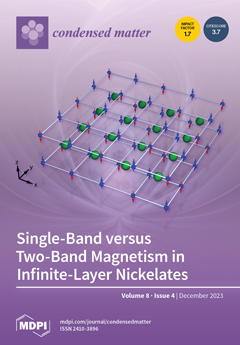The effect of the demagnetizing factor, regarding the determination of the de-pairing current density
, has been studied in the case of a Fe(Se,Te) crystal, using DC magnetic measurements as a function of a magnetic field (
H)
[...] Read more.
The effect of the demagnetizing factor, regarding the determination of the de-pairing current density
, has been studied in the case of a Fe(Se,Te) crystal, using DC magnetic measurements as a function of a magnetic field (
H) at different temperatures (
T). First, the lower critical field
(
T) values were obtained, and the demagnetization effects acting on them were investigated after calculating the demagnetizing factor. The temperature behaviors of both the original
values and the ones obtained after considering the demagnetization effects (
) were analyzed, and the temperature dependence of the London penetration depth
(
T) was obtained in both cases. In particular, the
(
T) curves were fitted with a power law dependence, indicating the presence of low-energy quasiparticle excitations. Furthermore, by plotting
as a function of
T, we found that our sample behaves as a multigap superconductor, which is similar to other Fe-11 family iron-based compounds. After that, the coherence length
values were extracted, starting with the
(T) curve. The knowledge of
and
allowed us to determine the
values and to observe how they are influenced by the demagnetizing factor.
Full article





